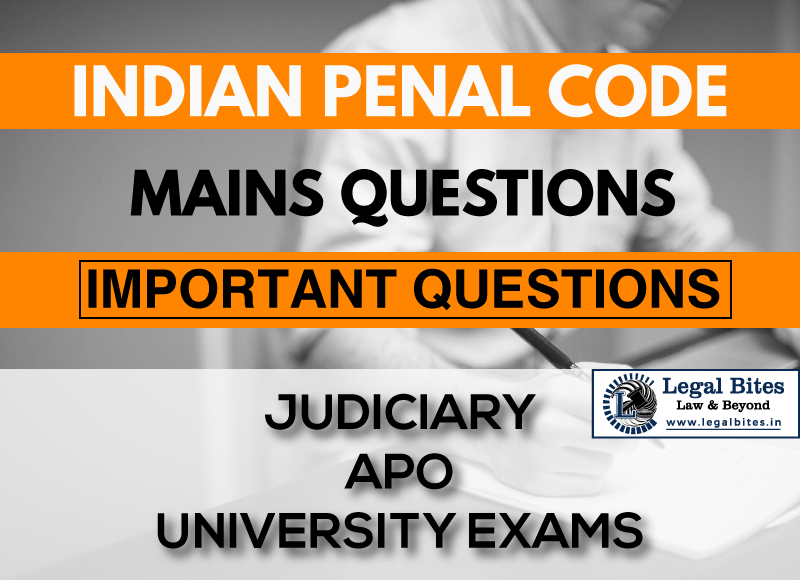A, a snake charmer exhibited in public a venomous snake whose fangs he knew, had not been extracted, and for showing his own skill and dexterity, however, without intention to cause harm to anyone, placed the snake on the head of one of the spectators……..
Question: A, a snake charmer exhibited in public a venomous snake whose fangs he knew, had not been extracted, and for showing his own skill and dexterity, however, without intention to cause harm to anyone, placed the snake on the head of one of the spectators. The spectator while trying to push off the snake was bitten by the… Read More »

Question: A, a snake charmer exhibited in public a venomous snake whose fangs he knew, had not been extracted, and for showing his own skill and dexterity, however, without intention to cause harm to anyone, placed the snake on the head of one of the spectators. The spectator while trying to push off the snake was bitten by the snake and consequently died. What offense, if any, was committed by A. Give reasons and also refer to the case law, if any, on the point. Find the answer to the...
Question: A, a snake charmer exhibited in public a venomous snake whose fangs he knew, had not been extracted, and for showing his own skill and dexterity, however, without intention to cause harm to anyone, placed the snake on the head of one of the spectators. The spectator while trying to push off the snake was bitten by the snake and consequently died. What offense, if any, was committed by A. Give reasons and also refer to the case law, if any, on the point.
Find the answer to the mains question only on Legal Bites [A, a snake charmer exhibited in public a venomous snake whose fangs he knew, had not been extracted, and for showing his own skill and dexterity, however, without intention to cause harm to anyone, placed the snake on the head of one of the spectators. The spectator while trying to push off the snake was bitten by the snake and consequently died. What offence, if any, was committed by A. Give reasons and also refer to the case law, if any, on the point.]
Answer
Section 300. Murder.— Except in the cases hereinafter excepted, culpable homicide is murder, if the act by which the death is caused is done with the intention of causing death, or—
If the person committing the act knows that it is so imminently dangerous that it must, in all probability, cause death or such bodily injury as is likely to cause death, and commits such act without any excuse for incurring the risk of causing death or such injury as aforesaid.
The essential ingredients of this clause are:
(i) the act must be imminently dangerous;
(ii) the person committing the act must have knowledge that it is so imminently dangerous;
(iii) that in all probability it will cause (a) death or (b) bodily injury as is likely to cause death, and
(iv) such imminently dangerous act should be done without any reason or justification for running the risk of causing death or such injury.
Under this clause, the act need not be directed at any particular individual nor need there be an intention to cause the death of any particular individual. It has to merely be a reckless act, which is imminently dangerous.
The mental element contemplated under this clause is ‘knowledge’ that the act is so imminently dangerous that it is likely to cause death or such bodily injury that is likely to cause death. The term ‘imminently dangerous’ requires that the danger should be immediate and close at hand. Hence, under this clause, the intention to kill anybody is not required in order to constitute the offense of murder. The recklessness and inexcusability of an act must be by the facts and circumstances of each case, because, such imminently dangerous acts causing death will amount to murder only if it has been done without any reasonable excuse for taking such a risk.
Illustration (d) to section 300: A without any excuses fires a loaded cannon into a crowd of persons and kills one of them. A is guilty of murder, although he may not have had a premeditated design to kill any particular individual
In Thangaiya v. State of Tamil Nadu [(2005) 9 SCC 650], the Supreme Court categorically ruled that cl (4) of section 300 would be applicable where the knowledge of the offender as to the probability of death of a person approximates to a practical certainty. Such knowledge on the part of the offender must be of the highest degree of probability.
Therefore, the knowledge of A, a snake charmer is to be deemed his intention of doing such an imminently dangerous will make him liable for the murder of the spectator. Hence, the act of A for the murder of the spectator is punishable under section 302, IPC.
Important Mains Questions Series for Judiciary, APO & University Exams
- IPC Mains Questions Series Part I: Important Questions
- IPC Mains Questions Series Part II: Important Questions
- IPC Mains Questions Series Part III: Important Questions
- IPC Mains Questions Series Part IV: Important Questions
- IPC Mains Questions Series Part V: Important Questions
- IPC Mains Questions Series Part VI: Important Questions
- IPC Mains Questions Series Part VII: Important Questions
- IPC Mains Questions Series Part VIII: Important Questions
- IPC Mains Questions Series Part IX: Important Questions
- IPC Mains Questions Series Part X: Important Questions
Admin Legal Bites
Legal Bites Study Materials correspond to what is taught in law schools and what is tested in competitive exams. It pledges to offer a competitive advantage, prepare for tests, and save a lot of money.

